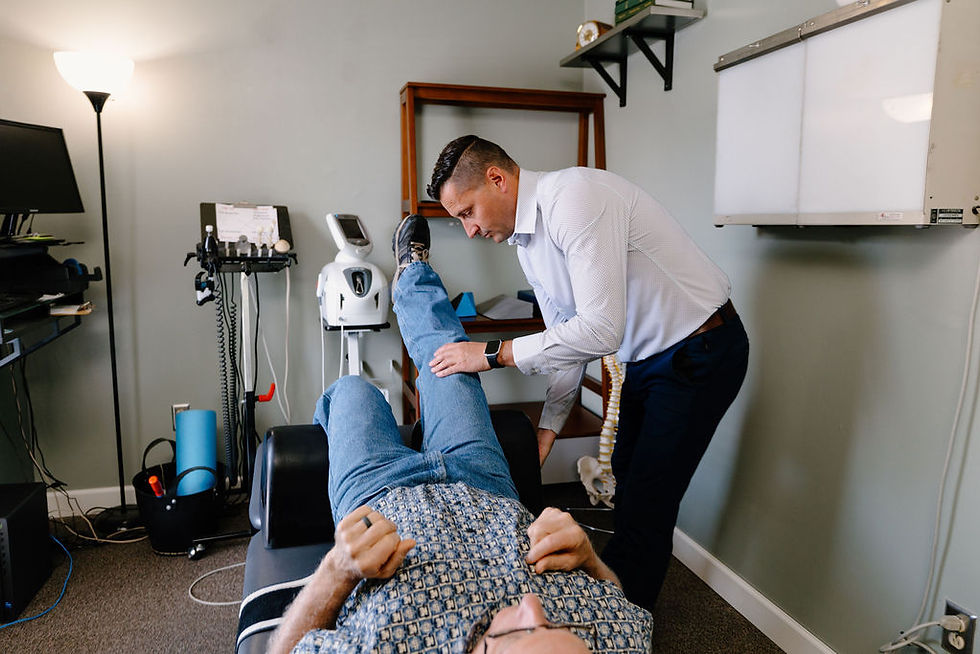Mobility 101: Simple Tests, Faster Fixes, Real Results (at Home)
- Atlas Rising

- Sep 5
- 3 min read

Film yourself doing three moves (shoulder reach, overhead squat, push-up) to spot mobility faults. Learn a true neutral posture, switch to diaphragmatic (belly) breathing, and follow a rotating 10–15-minute mobility plan 3–5×/week. Re-test every 30–60 days to track progress.
Why mobility matters
Good mobility = joints that move through full, controlled ranges without compensation. It protects your spine and joints, boosts strength/fitness, and prevents “computer posture” from turning into chronic neck, back, and shoulder pain.
Step 1 - Find your faults (3 quick at-home tests)
Pro tip: Record each test from the front and side. What you feel isn’t always what you’re doing.
1) Shoulder Mobility Reach
Make fists.
One arm reaches over the shoulder, the other behind the back.
Switch sides.
Goal: Fists within one fist-length of each other.
Red flags: Big left/right difference, painful pinching, wrist/hand “cheats.”
2) Overhead Squat
Feet hip-to-shoulder width, feet flat, arms straight overhead.
Squat as low as you can without heels lifting.
Watch for: Knees collapsing inward, torso collapsing forward, arms drifting forward, heels popping up.
Why it matters: Screens ankles → hips → spine in one move.
3) Push-Up (quality > quantity)
From straight plank, ribcage down, glutes on, lower as one piece.
Red flags: Hips piked up, low back sag, elbows flaring excessively, head jutting.
Tells you about: Core/bracing, shoulder control, mid-back strength.
Track it: Note date, side-to-side differences, and any pain. Re-test in 30–60 days.
Step 2 - Find (and feel) neutral posture
Most people stand with feet turned out, arches collapsed, hips forward, ribs flared, chin jutted. Neutral fixes that stack.
Standing neutral—checklist
Feet: “Screw” feet into the floor (create outward torque without moving them). Arches up; knees track over 2nd/3rd toes.
Hips: Squeeze glutes gently; pelvis stacks under you (no swayback).
Ribs: Take a quiet belly inhale; bring ribcage back over pelvis.
Head/neck: Ears over shoulders; long back of neck (not chin up).
Struggling? Practice the same stack lying on the floor (gravity helps) and carry it into sitting and lifting.
Step 3 - Breathe for mobility (and a calmer nervous system)
Chest-only breathing locks up the neck/ribs and keeps your “gas pedal” nervous system on. Switch to diaphragmatic breathing to unlock the torso and improve recovery.
1-minute test: One hand on chest, one on belly, lying down. Inhale through your nose—belly should rise first and expand like a 360° barrel (front + sides), then chest.
Daily reset (4–6 breathing):
Inhale 4 through nose → Exhale 6 through mouth.
Light, smooth, no breath holds.
5–10 minutes daily (commute, post-workout, or before bed).
Step 4 - Build a rotating mobility plan (10–15 min)
Don’t stretch the same hamstring forever. Rotate areas and mix soft-tissue work, mobility drills, and light activation.
Weekly example
Mon: Feet/ankles + calves (foam roll, ankle rocks, short-foot drills)
Tue: Hips/glutes (glute smash, hip flexor opener, 90/90 transitions)
Wed: Thoracic spine/ribs (peanut or foam roller, open books, wall slides)
Thu: Adductors/quads (lax ball inner thigh, couch stretch, Cossack squats)
Fri: Shoulders/scapula (lat/pec work, band pull-aparts, Y-T-W)
Sat/Sun: Walk + 5 minutes of your worst area
Anchor the habit: Attach mobility to something you already do (post-workout, after lunch, evening tea). Habit stacking wins.
Tools that help: Foam roller, 2 lacrosse/tennis balls (taped as a “peanut”), light resistance band.
What your patterns might be telling you
Upper Crossed pattern: Forward head, rounded shoulders, tight pecs/upper traps; weak mid-back/scapular stabilizers.
Lower Crossed pattern: Swayback, tight hip flexors/low back; weak glutes/abs.
Fix = restore joint motion, then balance tight vs. weak with targeted mobility and activation.
When to call a pro
Pain, numbness, or “catching” in a joint
You can’t reach neutral without strain
No change after 4–6 weeks of consistent work
A good clinician will restore joint motion, give precise drills, and make sure your plan fits your body.
Quick, printable checklist
Film shoulder reach (both sides), overhead squat, push-up (front + side)
Note gaps, compensations, pain
Practice standing/sitting neutral 1–2×/day
4–6 breathing 5–10 min/day
10–15 min mobility 3–5×/week (rotate regions)
Re-test in 30–60 days; adjust plan
FAQs
How fast will I improve?
Many feel better immediately; measurable changes show up in 2–4 weeks if you’re consistent.
Is stretching enough?
Usually not. Pair soft-tissue work + mobility drills + activation (teach the body to use the new range).
I can’t squat deep without falling forward.
Common culprits: ankle mobility, hip control, and ribcage flaring. Work ankles/hips and practice neutral; use a counterbalance goblet hold to groove the pattern.




Comments